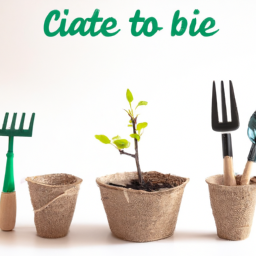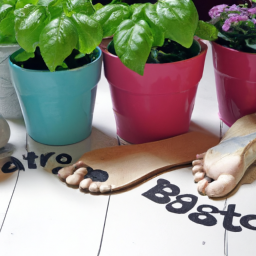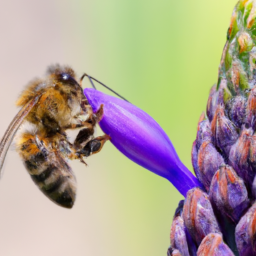
Pollinator-Friendly Gardens: Welcoming Beneficial Insects
Have you ever wondered how to create a garden that not only looks beautiful but also helps support the local ecosystem? Well, look no further! In this blog post, we will explore the fascinating world of pollinator-friendly gardens and how they can play a crucial role in welcoming beneficial insects. These gardens are not only a delight to the eye but also serve as a haven for the unsung heroes of our environment – the pollinators. So, whether you are an avid gardener or just starting out, join us on this journey to discover the secrets of creating a garden that not only thrives but also provides a safe haven for our buzzing friends.
The Importance of Pollinator-Friendly Gardens: Enhancing Biodiversity and Ecosystem Health
Welcome to the fascinating world of pollinator-friendly gardens! In this article, we will explore the importance of creating such gardens and how they contribute to enhancing biodiversity and ecosystem health. By understanding the vital role of pollinators and implementing simple steps, you can transform your garden into a haven for beneficial insects, supporting the delicate balance of nature.
The Role of Pollinators
Pollinators, including bees, butterflies, birds, and other insects, play a crucial role in plant reproduction and the overall health of ecosystems. They facilitate the transfer of pollen from the male part of a flower to the female part, enabling fertilization and the production of seeds and fruits. This process is essential for the survival and diversity of plant species, as well as the food sources they provide for other animals.
Without pollinators, many plants would struggle to reproduce, leading to a decline in their populations. This, in turn, would disrupt the food chain, affecting not only wildlife but also humans who rely on pollinator-dependent crops for sustenance. By creating pollinator-friendly gardens, we can actively support these vital creatures and promote the health of our environment.
So, how can you transform your garden into a welcoming space for beneficial insects and help enhance biodiversity and ecosystem health? Let’s dive into some practical steps:
1. Choose Native Plants
Native plants are adapted to the local environment and provide the best resources for native pollinators. They have evolved together over thousands of years, forming intricate relationships that support the survival of both plants and pollinators. By incorporating a variety of native plants in your garden, you can attract a diverse range of pollinators and create a thriving ecosystem.
Research the native plants in your region and select those that offer a continuous source of nectar and pollen throughout the growing season. Aim for a mix of flowering plants with different shapes, colors, and bloom times to cater to various pollinator species. Additionally, consider planting host plants that provide food and shelter for pollinators during their larval stages.
2. Provide Shelter and Nesting Sites
Pollinators need suitable habitats not only for foraging but also for nesting and overwintering. Incorporate features in your garden that provide shelter and nesting sites for different pollinator species. For example, leaving patches of bare ground, creating brush piles, or installing bee houses can attract solitary bees and other beneficial insects.
Consider adding water sources like shallow dishes or birdbaths with rocks or floating objects for pollinators to safely access water. Providing a diverse range of habitats will encourage a greater variety of pollinators to visit and establish their homes in your garden.
3. Avoid Pesticides and Herbicides
Chemical pesticides and herbicides can have detrimental effects on pollinators and other beneficial insects. These substances can contaminate nectar, pollen, and water sources, causing harm or even death to pollinators. To create a truly pollinator-friendly garden, opt for natural pest control methods and organic gardening practices.
Encourage natural predators like ladybugs and lacewings to control pests, and use companion planting techniques to deter harmful insects. Embrace the presence of some plant damage, as it can attract beneficial insects that feed on pests. By avoiding harmful chemicals, you not only protect pollinators but also create a safer environment for yourself, your family, and pets.
In conclusion, by creating a pollinator-friendly garden, you contribute to the enhancement of biodiversity and ecosystem health. The role of pollinators in plant reproduction and the overall balance of nature cannot be overstated. By choosing native plants, providing shelter and nesting sites, and avoiding pesticides and herbicides, you can make a significant positive impact on the well-being of pollinators and the environment as a whole.
So, grab your gardening tools and embark on this rewarding journey of transforming your garden into a haven for beneficial insects. Together, let’s create a world where pollinators thrive, and our ecosystems flourish!
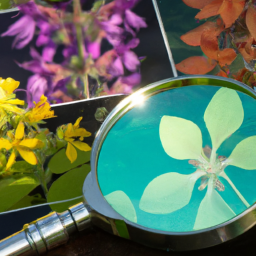
Creating a Welcoming Environment for Beneficial Insects in Your Garden
Introduction
Welcome to the world of pollinator-friendly gardens! In this guide, we will explore how you can create a welcoming environment for beneficial insects in your garden. These tiny creatures play a crucial role in pollination, helping your plants thrive and ensuring a bountiful harvest. By following these simple steps, you can attract and support a diverse range of beneficial insects, making your garden a haven for these helpful helpers.
Step 1: Provide a Variety of Flowering Plants
The first step in creating a pollinator-friendly garden is to provide a diverse range of flowering plants. Different beneficial insects are attracted to different types of flowers, so it’s important to offer a variety of shapes, sizes, and colors. Choose plants that bloom at different times throughout the year to provide a continuous food source for your insect friends.
Consider planting native wildflowers, as they are well-suited to your local ecosystem and will attract a wide range of beneficial insects. Some popular choices include coneflowers, black-eyed Susans, and milkweed. Additionally, herbs such as lavender, thyme, and dill are not only attractive to beneficial insects but can also be harvested for culinary use.
When selecting flowering plants, opt for those that have single, open flowers, as they are easier for insects to access. Double or densely-packed flowers may look beautiful to us, but they can be challenging for pollinators to navigate.
Step 2: Provide Shelter and Nesting Sites
In addition to food, beneficial insects also need shelter and nesting sites in your garden. By creating a welcoming habitat, you can encourage them to stick around and contribute to the overall health of your garden ecosystem.
One way to provide shelter is by incorporating native grasses and shrubs into your garden. These plants offer protection from predators and harsh weather conditions. You can also create small brush piles or leave fallen leaves and plant debris in a designated area to provide additional hiding spots.
Some beneficial insects, such as solitary bees and ladybugs, require specific nesting sites. You can install bee houses or bee blocks to attract solitary bees, and ladybug houses or piles of small rocks to provide shelter for these helpful predators.
Step 3: Avoid Pesticides and Chemicals
To truly create a pollinator-friendly garden, it’s important to avoid the use of pesticides and chemicals. These substances can be harmful to beneficial insects, as well as other wildlife and even humans. Instead, embrace natural pest control methods and work towards achieving a balance in your garden ecosystem.
Encourage natural predators, such as ladybugs, lacewings, and praying mantises, by providing them with a suitable habitat. These insects feed on common garden pests like aphids and caterpillars, helping to keep their populations in check.
If you do encounter pest problems, consider using organic pest control methods, such as handpicking pests, introducing beneficial insects, or using homemade sprays made from natural ingredients like neem oil or garlic.
Conclusion
Creating a welcoming environment for beneficial insects in your garden is not only beneficial for your plants but also for the overall health of your garden ecosystem. By providing a variety of flowering plants, shelter, and avoiding harmful chemicals, you can attract and support a diverse range of pollinators and natural predators. So, roll up your sleeves, put on your gardening gloves, and get ready to welcome these amazing creatures into your garden!
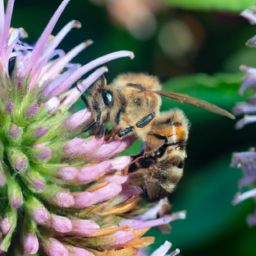
Designing and Maintaining Pollinator-Friendly Gardens: Tips and Best Practices
Introduction
Creating a pollinator-friendly garden is not only aesthetically pleasing but also plays a vital role in supporting the ecosystem. By providing a welcoming environment for beneficial insects, such as bees, butterflies, and other pollinators, you can contribute to the pollination of plants and ensure the survival of various species. In this guide, we will explore the essential tips and best practices for designing and maintaining a pollinator-friendly garden.
Understanding Pollinator-Friendly Gardens
Before diving into the design and maintenance aspects, it’s crucial to understand what makes a garden pollinator-friendly. Such gardens aim to attract and support pollinators by offering them suitable habitats, food sources, and protection. By incorporating specific elements into your garden, you can create an environment that not only attracts pollinators but also provides them with the resources they need to thrive.
Choosing the Right Plants
Selecting the right plants is the foundation of a successful pollinator-friendly garden. Opt for a diverse range of native flowering plants that bloom at different times throughout the year. This ensures a continuous supply of nectar and pollen for pollinators. Research the native plants in your region that are known to attract bees, butterflies, and other beneficial insects. Some popular choices include lavender, coneflowers, milkweed, and sunflowers.
When choosing plants, consider their shape, color, and fragrance. Different pollinators are attracted to specific characteristics, so a variety of plants will cater to a wider range of pollinators. Additionally, include plants with different heights and structures to provide shelter and nesting opportunities for insects.
Creating a Suitable Habitat
Apart from providing food sources, a pollinator-friendly garden should also offer a suitable habitat for beneficial insects. Incorporate features such as water sources, nesting sites, and sheltered areas. A shallow birdbath or a small pond can serve as a water source for pollinators to drink from and cool down. Adding rocks, logs, or even a small brush pile creates hiding spots and shelter for insects.
Consider leaving some areas of your garden untamed, with wildflowers or native grasses, to provide nesting sites for ground-nesting bees and other insects. Avoid using pesticides and herbicides, as they can harm pollinators. Instead, focus on natural pest control methods, such as companion planting and attracting beneficial insects like ladybugs and lacewings.
Maintaining a Pollinator-Friendly Garden
To ensure the long-term success of your pollinator-friendly garden, regular maintenance is crucial. Here are some best practices to keep in mind:
1. Watering: Provide regular watering, especially during dry spells, to support both plants and pollinators. Use a drip irrigation system or water at the base of plants to minimize water loss and prevent water from evaporating quickly.
2. Weeding: Regularly remove weeds to prevent competition for resources and to maintain a tidy garden. However, be cautious when weeding, as some weeds may actually be beneficial to pollinators. Research which weeds can coexist harmoniously with your garden’s ecosystem.
3. Mulching: Apply a layer of organic mulch around plants to retain moisture, suppress weeds, and provide insulation for beneficial insects during extreme temperatures. Use natural materials such as wood chips, straw, or compost.
4. Pruning: Prune plants as needed to promote healthy growth and maintain their shape. Pruning also helps remove dead or diseased plant parts that may attract harmful pests.
5. Observing and learning: Regularly observe your garden to identify any issues or opportunities for improvement. Learn about the different pollinators that visit your garden and their specific needs. This knowledge will help you make informed decisions regarding plant selection and garden maintenance.
Conclusion
Designing and maintaining a pollinator-friendly garden is a fulfilling endeavor that benefits both the environment and your own enjoyment of nature. By following the tips and best practices outlined in this guide, you can create a vibrant and thriving habitat for beneficial insects. Remember to choose the right plants, create a suitable habitat, and maintain your garden with care. With time, your pollinator-friendly garden will become a haven for bees, butterflies, and other pollinators, contributing to the conservation of these essential species.
Key Takeaways of this article
Pollinator-friendly gardens are not only beautiful but also play a crucial role in supporting beneficial insects. These gardens are designed to attract and provide a habitat for a wide range of pollinators, including bees, butterflies, and other insects. By creating a welcoming environment for these creatures, we can help protect and enhance our ecosystem.
One way to create a pollinator-friendly garden is by planting a variety of native flowering plants. These plants have evolved alongside local pollinators and provide them with the nectar and pollen they need to survive. It’s important to choose a mix of plants that bloom at different times throughout the year to ensure a continuous food source for the pollinators. Additionally, avoiding the use of pesticides is crucial as they can harm not only the target pests but also beneficial insects. Instead, consider using natural pest control methods or companion planting techniques to keep unwanted insects at bay.
In conclusion, creating a pollinator-friendly garden is a simple yet impactful way to support beneficial insects. By providing them with a welcoming habitat and a diverse range of flowering plants, we can contribute to the conservation of these essential pollinators. So, why not transform your garden into a haven for bees, butterflies, and other beneficial insects?
Q&A Corner:
Q1: Why should I create a pollinator-friendly garden?
A1: Creating a pollinator-friendly garden is not only beneficial for the environment but also for your own garden. By attracting beneficial insects like bees, butterflies, and ladybugs, you can enhance pollination, leading to healthier and more abundant plants. Additionally, these insects act as natural pest control, reducing the need for harmful pesticides.
Q2: How can I make my garden attractive to beneficial insects?
A2: To make your garden welcoming to beneficial insects, there are a few key steps you can take. First, choose a variety of native plants that provide nectar, pollen, and shelter for these insects. Avoid using pesticides, as they can harm beneficial insects. Provide a water source, such as a shallow dish with pebbles, for them to drink from. Finally, consider creating diverse habitats within your garden, including meadows, flower beds, and even small ponds or bird baths.
Q3: What are some examples of pollinator-friendly plants?
A3: There are numerous plants that are attractive to beneficial insects. Some popular choices include lavender, sunflowers, coneflowers, bee balm, milkweed, and daisies. It’s best to select a mix of flowers that bloom at different times throughout the year to provide a continuous food source for pollinators.
Q4: How do I maintain a pollinator-friendly garden?
A4: Maintaining a pollinator-friendly garden involves regular care and attention. Ensure that your plants receive adequate water and sunlight. Remove any weeds or invasive plants that may compete with your pollinator-friendly plants. Deadhead flowers regularly to encourage new blooms. Consider leaving some areas of your garden untrimmed during winter to provide shelter for overwintering insects.
Q5: Are there any specific gardening practices I should avoid?
A5: Yes, there are a few practices to avoid when creating a pollinator-friendly garden. Avoid using chemical pesticides, as they can harm beneficial insects. Instead, opt for organic pest control methods or natural alternatives. Additionally, try to minimize the use of synthetic fertilizers, as excessive nutrients can negatively impact the ecosystem. Finally, avoid planting invasive species, as they can outcompete native plants and disrupt the natural balance of your garden.

Alex Turner is a sustainable gardening advocate and the founder of an acclaimed indoor gardening blog. With a focus on eco-friendly practices and urban sustainability, Alex combines his background in environmental studies with his love for plants to educate readers on mindful indoor gardening. His work highlights the importance of nurturing both plants and the planet.

